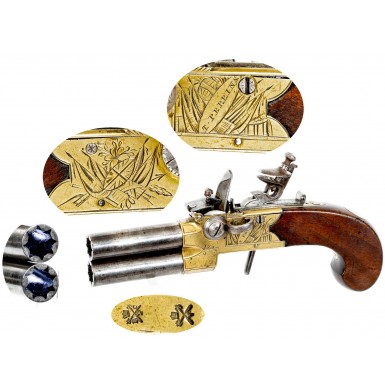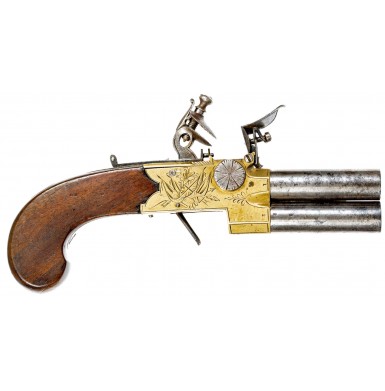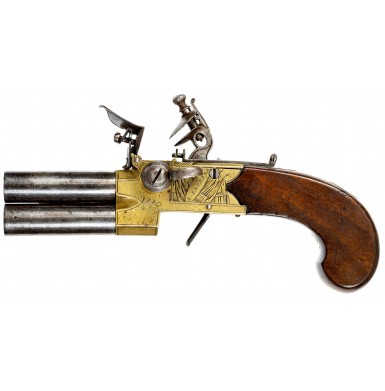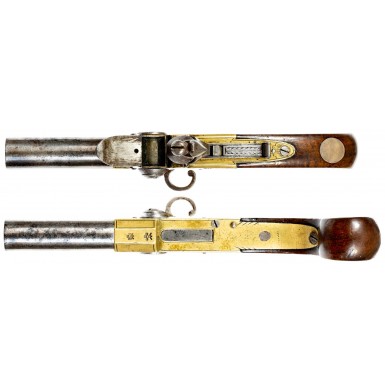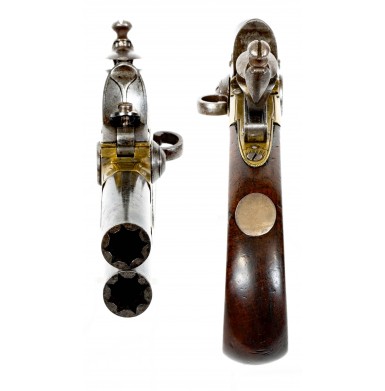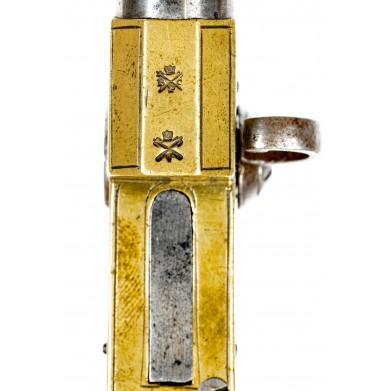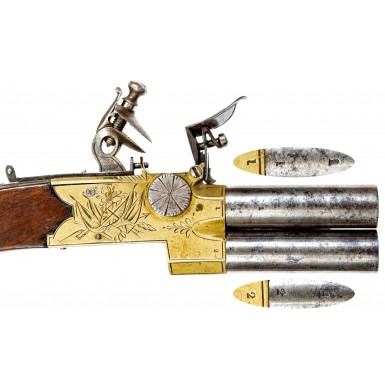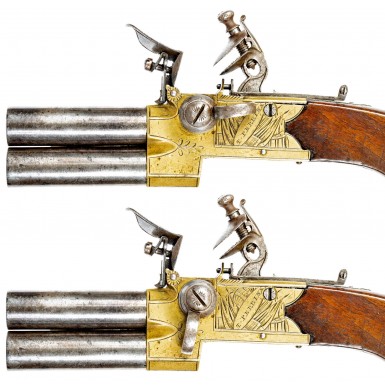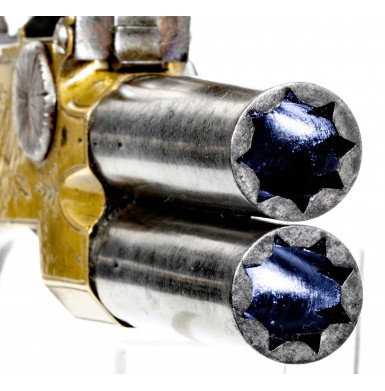Attractive Tap Action Pistol by Thomas Perrins of Windsor
- Product Code: FHG-2262-SOLD
- Availability: Out Of Stock
-
$1.00
This is a really attractive example of what is referred to as a Tap Action flintlock pistol. Form the time that firearms were introduced, gunsmiths had experimented with various ways to turn those single shot weapons into multi shot weapons. One of the easiest and most successful systems, prior to true “repeating” firearms, was to use multiple barrels, each with their own load and charge. In Great Britain, many pocket pistols were produced with two to four barrels and sometimes even more. The downside to most of these early designs was that that all of the barrels typically discharged simultaneously. This resulted in heavy recoil, low accuracy and no quick way to get off a second shot if needed. The Tap Action system solved the problem.
The flintlock pistol design typically incorporated two barrels, one located above the other. A manually rotated flash chamber in the frame allowed the shooter to fire each barrel individually or to fire them both simultaneously. With the “tap” in the “up” position, only the flash hole to the upper barrel was exposed to the spark generated by the powder in the pan. With the “tap” in the down position, the flash channel connected to the chamber of the bottom barrel. The lower tap was dished to contain powder, so that after the upper barrel was fired, all you had to do was flip the side lever to reorient the tap, re-cock the pistol and fire the lower barrel. If you wanted to fire both barrels at the same time, you could start with the tap in the down position and the flash would reach both chambers. This system also gave you the ability to fire the upper barrel quickly if it failed to detonate on the first try. The solution was simple and elegant, easy to use and was quite popular on higher end pocket pistols during the late 18th and first half of the 19th centuries.
This nice example of an English Tap Action Flintlock Pistol offered here was manufactured during the second quarter of the 19th century by gunmaker Thomas Perrins who worked in Windsor, Berkshire. Windsor, which is located about 20 miles west of Charring Cross, central London, is best known as the location of Windsor Castle. According to period directories, Perrins worked at 80 Peascod Street from 1843-1851, the firm becoming Thomas Perrins & Son in 1852 and remaining at the same address through 1868.
The pistol is a brass framed, tap action flintlock with two iron “Turn Off” barrels to allow the pistol to be loaded. As is typical of twist off pistols of the era, the muzzles have a multi-pointed star shape, designed to accept a wrench that allowed the barrels to be removed and reinstalled. This unique shape is not rifling, although some collectors refer to the socket shape of the muzzles as “false rifling”. The 2 3/16” round barrels have smooth bores and are 54-Bore, approximately .44 caliber. The overall length of the gun is about 7 3/8”. The brass frame of the pistol is engraved T. PERRINS in a panel surrounded with a panoply of arms on the reverse and with another stand of arms on the obverse. No location is given on the gun. Interestingly, while modern authors list Perrins in books on gunmakers of Birmingham and the Regions, his location in a historical London suburb would allow him to use a “London” marking with impunity. Since Perrins was located only a day’s ride from central London, he likely had his arms proved in the London Proof House rather than the more distant Birmingham Proof House and was likely a member of the London gunmaker’s guild, the Worshipful Company of Gunmakers.
The bottom of the fame is marked with post-1813 Birmingham proof marks. This mark suggest Perrins may have simply retailed the gun, rather than made it, as he would have likely used the London Proof House. The barrels are engraved with the matching numbers 1 and 2 which match the same number on the obverse of the frame to ensure that the correct barrel is mated with the correct chamber. The barrels also both have an additional 1 on them, suggesting that this pistol was originally part of a pair. Thus, these are barrels 1 and 2 of the first gun in the pair. As is typical of most of the pistols of this style, the gun is a box lock, flint ignition design with a folding trigger and sliding safety on the top of the frame. The safety not only locks the hammer in the half cock position, but also locks the flash pan closed. The safety works just as it should. The action of the pistol also works correctly on both the half cock and full cock positions and pulling the hammer to the full cock position releases the folding trigger from the frame to allow it to fire the pistol. The frizzen spring remains strong and the pan opens and closes, as it should. The Tap Action mechanism is mounted on the reverse of the frame and works perfectly, rotating the flash chambers as it should. When the frame mounted lever is raised only the upper flash channel is expose and when it is depressed both flash channels are open.
The pistol remains in about NEAR VERY GOOD condition. The brass frame was likely cleaned some time ago and has mellowed somewhat to a medium golden mustard colored patina. All of the engraving and markings remain clear and crisp on the frame. As noted, the action of the pistol functions as it should. There are two screws in the top of the frame that secure the top portion of the frame to the sides and one of those screws is missing. The iron barrels have a mostly dove gray patina with only some minute traces of flecked blue remaining. There is scattered surface oxidation and discoloration on the barrels along with some minor surface roughness and light pinpricking in some areas. The barrels retain good smooth bore with some scattered oxidation, discoloration and scattered pinpricking. Both barrels are frozen to the frame and would require a barrel tool to remove them from the frame. The smooth, flat-sided one-piece walnut grip is in about VERY GOOD condition as well. The grip is fitted with a nominally ¾” by ½” oval German silver escutcheon behind the tang. The thumbpiece is not engraved with any initials or crests. It is solid and complete and free of any breaks or repairs. The grip shows some scattered minor bumps, dings and handling marks, as would be expected.
Overall, this is an attractive example of a late flintlock period tap action pocket pistol. The pistol is in very good condition, and it 100% original and totally unmolested. This would be a lovely addition to any collection of English flint or pocket pistols and is very reasonably priced, making it a “lot of gun for the money” as one of my friends likes to say.
SOLD
Tags: Attractive, Tap, Action, Pistol, by, Thomas, Perrins, of, Windsor

